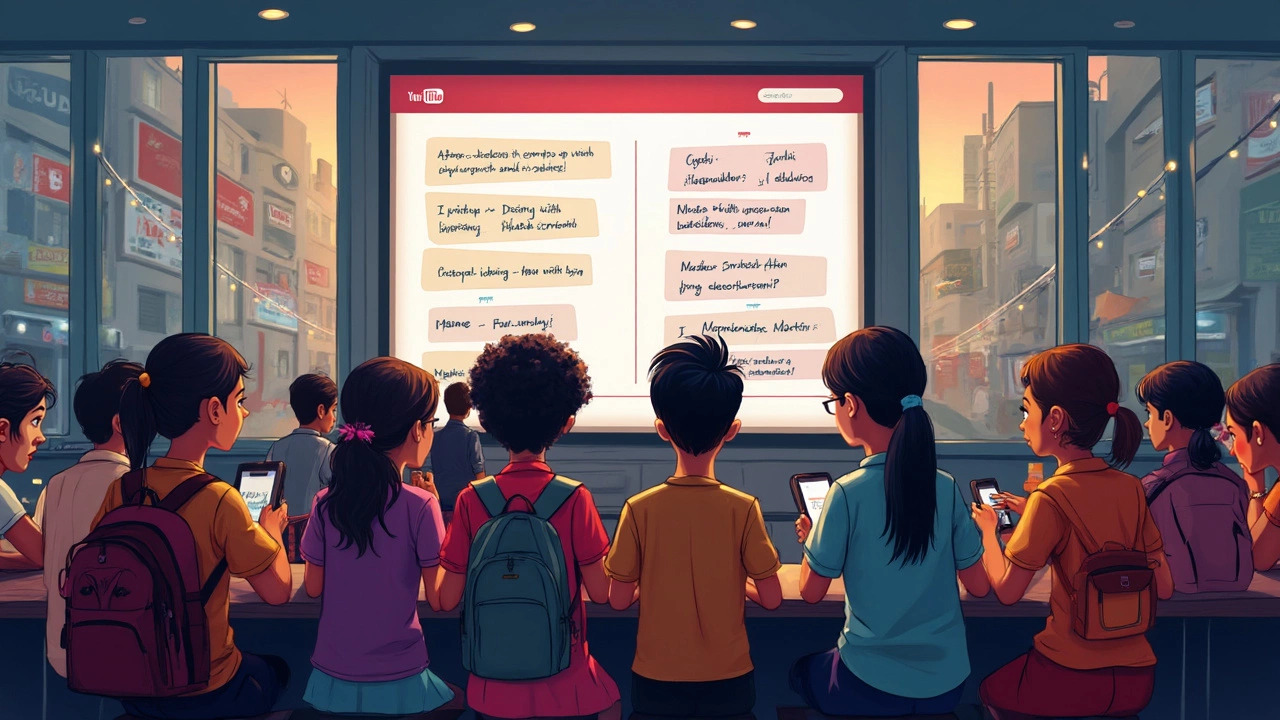So, can you actually learn English by watching YouTube? Yep, it’s possible. We're not talking about just picking up a few words here and there. With the right approach, you can seriously improve your English skills. The convenience is unmatched—just grab your phone or laptop, and you're good to go. But before diving headfirst into the vast sea of videos, there's some stuff you need to know.
YouTube isn't just for cat videos or makeup tutorials; there's a massive amount of educational content out there. Some channels are run by teachers or even language experts. They often use engaging, we’ll say sometimes quirky, methods that make learning feel less like a chore and more like fun. But be careful, not all videos are created equal. Quality and accuracy can vary, so you'll want to choose carefully.
Get ready to explore some of the most effective ways to use YouTube for learning English, what you should look out for, and how to supplement your newfound skills. If you're ready to take your English skills to the next level, this might just be your ticket.
- The Popularity of YouTube Learning
- Choosing the Right Channels
- Effective Techniques to Try
- Pitfalls and How to Avoid Them
- Supplementing YouTube Learning
The Popularity of YouTube Learning
In recent years, learning through YouTube has exploded in popularity. With over 2 billion users logging in every month, the platform is a hub for creators sharing knowledge on just about anything. The educational channels have gained a massive audience, and for good reason. The flexibility and accessibility YouTube offers is a game-changer for people seeking to learn English or any language, really.
What makes YouTube so appealing is its ability to cater to different learning styles. Whether you learn better through visuals, listening, or interactive content, there's something for everyone. Plus, most of it is free, which is a big plus. You can watch a short video on your lunch break or dive into a longer lesson when you've got more time.
A study found that 74% of people use YouTube to help them with problems they encounter in life. And when it comes to language, there's a whole array of content—from beginner English courses to advanced grammar tutorials—that's right at your fingertips. YouTube is essentially a 24/7 classroom, accessible whenever it suits you.
While traditional classrooms might still be the go-to for many, YouTube opens up possibilities for those who can’t attend regular courses due to time constraints or costs. It’s nothing short of a revolution in education accessibility. Imagine being able to learn English from a native speaker directly from your living room in Moscow, Rio, or Delhi. Those barriers people once faced are slowly disappearing thanks to platforms like YouTube.
If you're just getting started on this learning journey, you'll find plenty of recommendations and tips from other learners on which channels offer the best content. And with all those glowing subscriber counts and comments, you can easily see which ones have made an impact.
Choosing the Right Channels
With so many options out there, picking the right YouTube channels to help you learn English can feel overwhelming. But don’t worry, there are some straightforward ways to make sure you’re getting quality content.
First off, look for channels that are run by experienced instructors or language experts. This doesn't just mean anyone with a fancy background. It means those who can teach English in a way that makes sense and keeps you interested. For example, channels like 'English with Lucy' and 'BBC Learning English' are well-known for their professional and engaging content. They cover everything from basic grammar to advanced pronunciation tips.
Next, pay attention to channels that incorporate different learning styles. Do they use visuals, catchy songs, or relatable scenarios? These elements can make a big difference, especially if you find yourself easily bored by traditional methods. Look for channels like 'Rachel’s English', where you’ll get plenty of visual aids to understand mouth movements and sounds.
Don't forget to check the channel’s subscriber count and viewer comments. A high number of subscribers usually means people trust the content. However, don't just rely on numbers—comments can give you an idea of whether people actually find the videos helpful.
If you're still unsure, spend a few minutes watching a couple of videos. Do you like the teaching style? Is the content relevant to what you want to learn? If the answer is yes, hit that subscribe button.
- Look for expert-backed channels.
- Seek engaging, multi-style methods.
- Check subscriber count and feedback.
- Sample videos before committing.
In the end, finding the right channel is about aligning their teaching style with your learning needs. Happy watching and happy learning!

Effective Techniques to Try
Okay, so you’re ready to give this YouTube thing a go for learning English. Here’s how to make sure you get the most bang for your buck—or in this case, your time investment.
First off, making the learning active is key. An easy way to do this is by using the shadowing technique. Listen to a phrase, pause the video, then try to mimic the pronunciation and intonation. This helps you with both speaking and listening skills.
Don’t skip incorporating subtitles. Start with English subtitles, as they will help link sounds to words. Once you get more comfortable, turn them off to test your understanding. This little trick is supported by a study from Cambridge University that found learners retained vocabulary better when they saw and heard words simultaneously.
"Listening and reading while learning a new language improves understanding and retention more than focusing on one skill alone." - Language Expert, Dr. Sarah Collins
If you want to focus on grammar, look for specific channels that cover detailed lessons. You’ll find playlists that take you from beginner to advanced levels. Take notes as you go, and don't just watch—pause and actively practice.
- Choose videos that match your current skill level—no sense diving into something too hard or too easy.
- Re-watch videos. Repetition is your friend; it reinforces what you’ve learned.
- Engage with the community in the comments. This will help you practice writing and make connections with other learners.
Finally, you might want to check your progress. YouTube offers an analytics feature called 'Watch History' where you can see how much time you've spent learning. Try setting a time target each week to hold yourself accountable.
Pitfalls and How to Avoid Them
When you're learning English on YouTube, it's easy to get sucked into some traps. The journey is full of opportunities to make mistakes, but don't worry—knowing what to look out for can save you headaches. Let's dive into the common pitfalls and how to sidestep them.
First up, there's the issue of quality. Not every video out there is reliable. Some creators don’t have the proper credentials or experience, leading to videos filled with incorrect grammar or misleading pronunciation. So, always check the creator's background and read the comments for feedback from other learners.
Another trap is focusing too much on passive watching. You might think you're absorbing the content just by watching, but language learning requires active participation. Make it a point to repeat after the teacher, pause to write down notes, or even shadow the speaker's pronunciation.
And let's talk about consistency—or the lack of it. It's tempting to binge-watch hours of lessons but spreading your learning over several weeks offers better results. Create a schedule to ensure regular practice rather than sporadic deep dives.
Avoid getting distracted by unrelated content. YouTube's recommendation system might pull you toward other non-educational videos. It's like walking into a bookstore for a specific book and getting lost in a maze of shiny covers. Stick to your English learning path by creating playlists of educational videos you plan to watch.
- Engage with the content. Take quizzes or follow up with exercises mentioned in videos for deeper understanding.
- Join online forums. Connect with fellow learners discussing the same videos for collaborative learning.
- Limit distractions. Use browser extensions to block unrelated video suggestions.
Keep these in mind, and you'll avoid the common stumbles on your English learning journey with YouTube.

Supplementing YouTube Learning
Watching YouTube learning videos is great, but if you want to take full advantage of learning English, combining these videos with other resources is key. Just like a balanced diet, you need a mix to get the best results.
First off, practice speaking. Watching videos won't magically make you pronounce words like a native, so try speaking out loud. Maybe even participate in language exchange meet-ups or online groups where you can chat with others learning English. It’s like having a gym buddy for language practice. Duolingo’s speaking exercises can be a game-changer for putting what you watch into practice.
Reading is another biggie. Sure, videos give you sound, but reading helps with word recognition and grammar. Try reading English blogs, magazines, or even simple novels. You’ll be surprised how many phrases from YouTube start to make more sense on paper.
Don't forget about mobile apps. They’re handy when you’re on the move. Apps like Anki for flashcards or Memrise offer daily practice that can cement words and grammar in your memory.
- Tip: Create a vocabulary list from new words you encounter in videos. Review and use these words in sentences to boost retention.
- Tip: Set a realistic schedule. Like any habit, regularity is key. Maybe watch a video daily, practice for 15 minutes, and read for another 10 minutes.
Don't just focus on input; output is crucial too. That's why writing, whether it’s keeping a journal or posting on sites like Lang-8 where users can correct each other's writing, is super helpful. You can also use websites like Grammarly to check your writing. This feedback loop solidifies learning.
Finally, if you’re really committed, consider taking an online course for a more structured approach. Platforms like Coursera and FutureLearn offer courses specifically for non-native English speakers. They often include interactive activities to strengthen what you’ve learned on YouTube.
Mix these methods in, and you'll find that learning English on YouTube is just the start. By supplementing video learning with these additional resources, you're setting yourself up for success.





